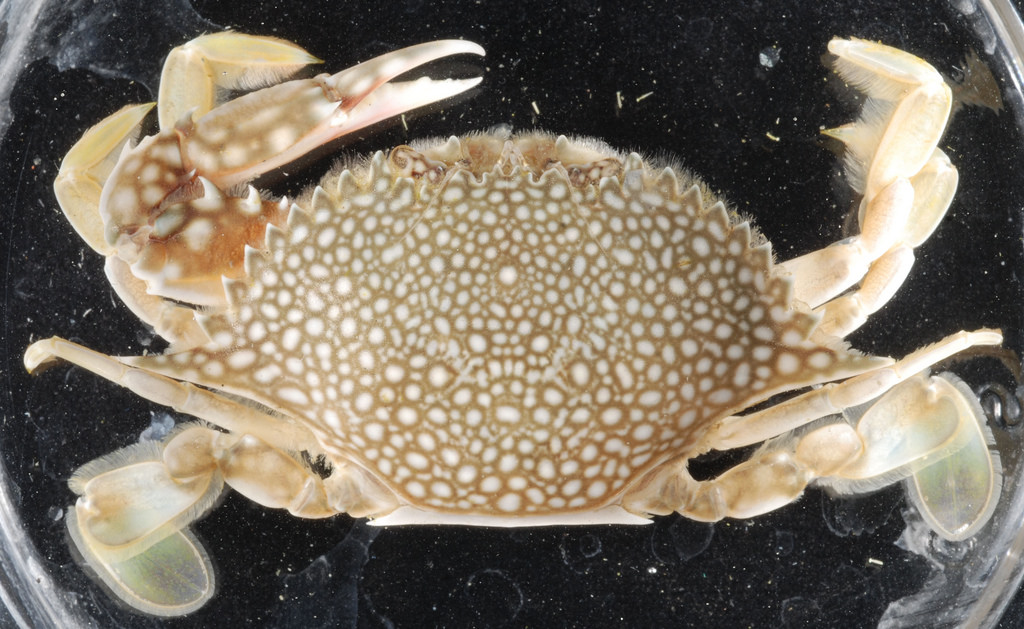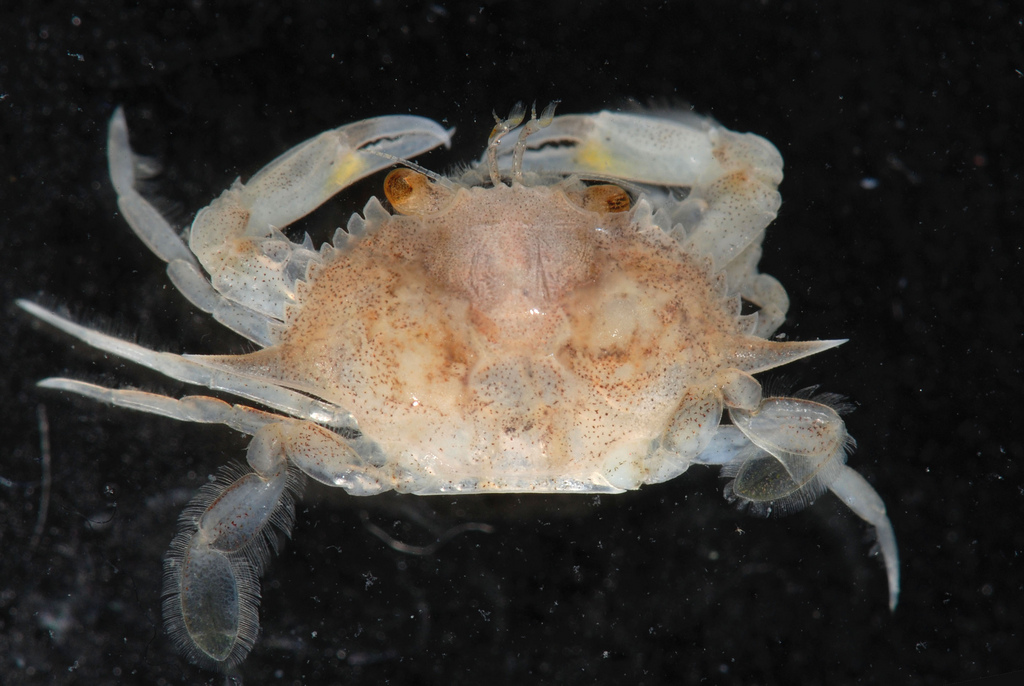Map Snapshot


2 Records
Seasonality Snapshot
Source: Wikipedia
| Arenaeus cribrarius | |
|---|---|

| |
| Scientific classification | |
| Domain: | Eukaryota |
| Kingdom: | Animalia |
| Phylum: | Arthropoda |
| Class: | Malacostraca |
| Order: | Decapoda |
| Suborder: | Pleocyemata |
| Infraorder: | Brachyura |
| Family: | Portunidae |
| Genus: | Arenaeus |
| Species: | A. cribrarius
|
| Binomial name | |
| Arenaeus cribrarius (Lamarck, 1818)
| |
| Synonyms[1] | |
| |
Arenaeus cribrarius, the speckled swimming crab, is a species of swimming crab in the family Portunidae.[2][3][4]
Habitat
[edit]The crabs can be found from Massachusetts, U.S. to areas in Argentina.[5] They are common in shallow water on sand in ocean beaches, but can be found in depths up to two hundred feet (61 m) deep.[6] They are typically found in temperate or tropical waters between eleven and twenty-nine degrees Celsius with a salinity between twenty-eight and thirty-five PSU.[7] Arenaeus cribrarius often bury themselves entirely in sand, but leave a gap for water to pass to their gills.[6] The crabs maintain the gap by clearing the sand with their claws and hairs around their mouth area.[6] Arenaeus cribrarius is a nocturnal and solitary organism, which only interacts with other crabs of its species when it wants to breed.[7]
Feeding
[edit]The Speckled swimming crab eats primarily detritus, but have also been recorded eating fish, mollusks, and other crustaceans.[7] They ambush prey that go near their buried bodies.[7] Speckled swimming crabs have been recorded capturing sea turtle hatchlings.[7] Sea turtles are the primary predator to Arenaeus cribrarius.[7] The crabs use their coloration and spines to ward off such predators.[7]
Anatomy
[edit]They share a very similar overall shape with the Atlantic Blue Crab.[6] The carapace of a Speckled swimming crab is light brown, light maroon, or olive with many white or tan irregular round spots.[6] The males tend to be more colorful.[6] The carapace can reach lengths between 4.5 and 6 inches wide (~120-150mm).[6] Each side of the carapace consists of nine lateral teeth with the last extending outward.[6] Between the eye sockets there are six partially fused frontal teeth.[6]
Arenaeus cribrarius has ten legs since it is a part of the order decapoda.[6] The first four pairs of legs have yellow tips and are used for walking.[6] These are referred to as broad pereopods.[6] They fifth pair of pereopods are used for swimming.[6] They are a wide flattened paddle shape.[6] Overall, Arenaeus cribrarius can weigh as much as forty-five grams (1.6 ounces).[6]
Reproduction
[edit]When the Arenaeus cribrarius reaches sexual maturity around five to seven years of age they begin to mate.[6] Arenaeus cribrarius breed year-round and are polygynandrous.[8] The male crab, who is between molts, will select a premolt female who is expressing courtship behavior.[9] The crabs communicate with one another through chemical, visual, and acoustic cues.[8] The male then carries the female for thirty days in a precopulatory position under his body until the female molts.[7][9] When the female's shell is still soft the male will invert her to position themselves with their abdomens in contact together.[7] The male then transfers his spermatophores to her gonopores.[7] Once mating has occurred, the eggs will spawn around fifty-seven days later and will have an fecundity between 135,000 and 680,000.[9] Nauplia will hatch from the Speckled swimming crab eggs around eighteen days and will grow into the first stage of crab thirteen days later.[9] The average age for a Speckled swimming crab is two years.[9]
Commercial usage
[edit]In some parts of the world Arenaeus cribrarius is important in fisheries, particularly along the Brazilian coast.[9] The crab is harvested for its meat and residual proteins are used to produce fertilizers and feed for livestock.[9] Along with the consumption of meat, the Speckled swimming crab is harvested for its byproducts.[9] Chitin can be extracted from the crab and used in products like adhesives, cosmetics, photographic emulsions, and anticoagulants.
References
[edit]- ^ "Speckled Swimming Crab: Arenaeus cribrarius (Lamarck, 1818)". BioLib.
- ^ "Arenaeus cribrarius Report". Integrated Taxonomic Information System. Retrieved 6 May 2018.
- ^ "Arenaeus cribrarius". GBIF. Retrieved 6 May 2018.
- ^ "Arenaeus cribrarius Species Information". BugGuide.net. Retrieved 6 May 2018.
- ^ Alexandre Ribeiro da Silva; Barioto, João Gabriel; Grabowski, Raphael Cezar; Antonio Leão Castilho.Biologia; Heidelberg Vol. 72, Iss. 3, (2017): 325-332.
- ^ a b c d e f g h i j k l m n o p DeVictor, Susan T.; Knott, David M.; Crowe, Stacie E. (2010). South Carolina Beachcomber’s Guide - A Guide to the Common Invertebrates, Plants and Natural Artifacts of the South Carolina Seashore. Charleston, South Carolina: South Carolina Department of Natural Resources. p. 59. OCLC 859271103.
- ^ a b c d e f g h i j S, Abel; oval; Wroblewski, Thomas. "Arenaeus cribrarius (speckled swimming crab)". Animal Diversity Web. Retrieved 1 July 2019.
- ^ a b Pinheiro, M., A. Fransozo. 1999. Reproductive behavior of the swimming crab Arenaeus cribrarius (Lamarck, 1818) (Crustacea, Brachyura, Portunidae) in Captivity. Bulletin of Marine Science, 64(2): 243-253.
- ^ a b c d e f g h Andrade, Luciana S; Fransozo, Vivian; Bertini, Giovana; Negreiros-Fransozo, Maria L; López-Greco, Laura S.
External links
[edit] Media related to Arenaeus cribrarius at Wikimedia Commons
Media related to Arenaeus cribrarius at Wikimedia Commons

